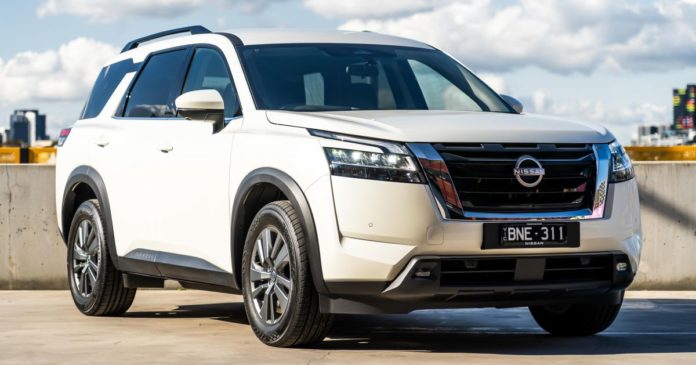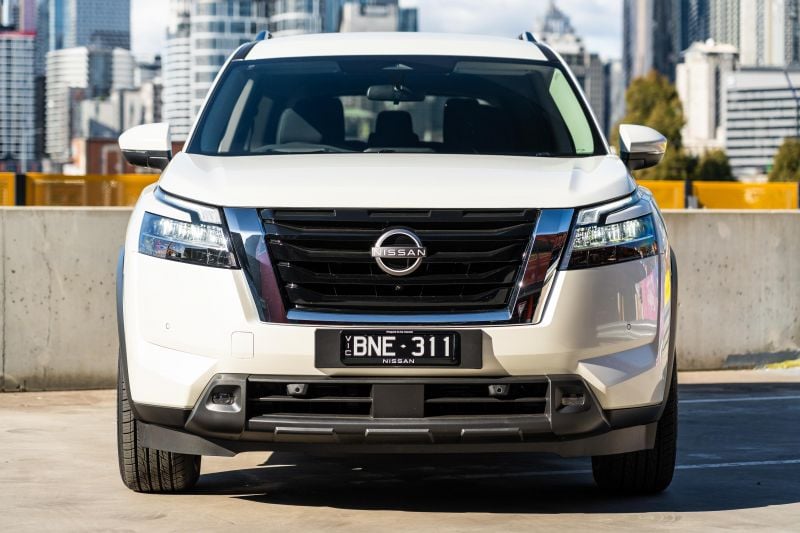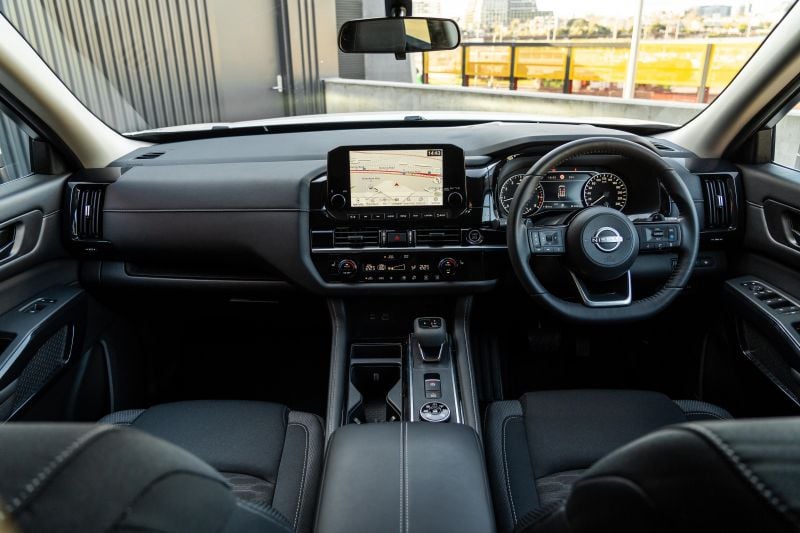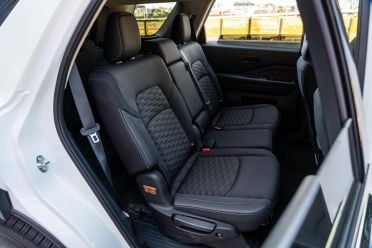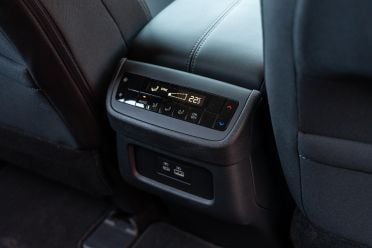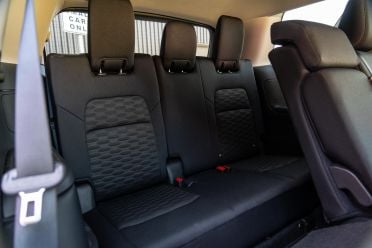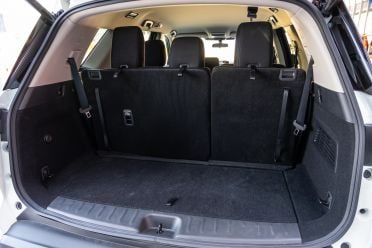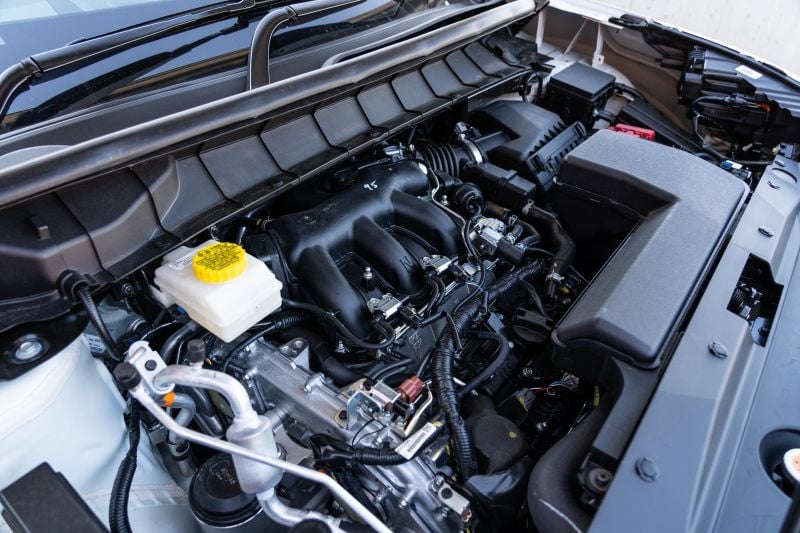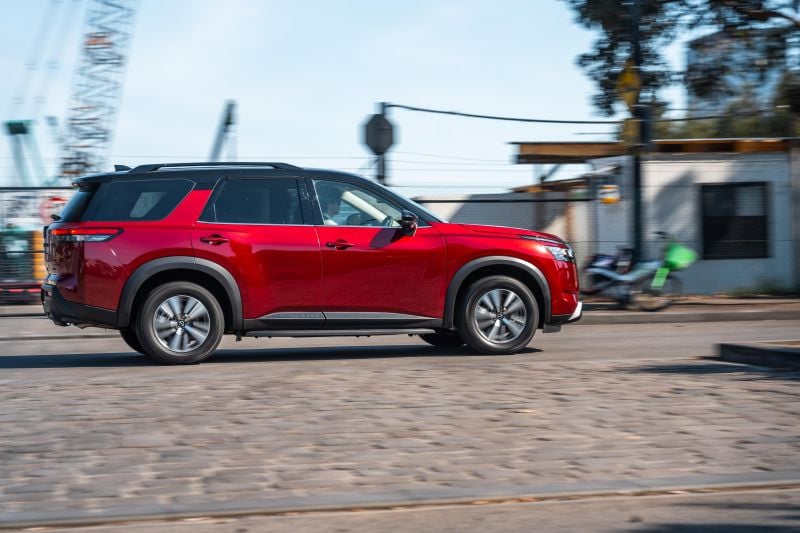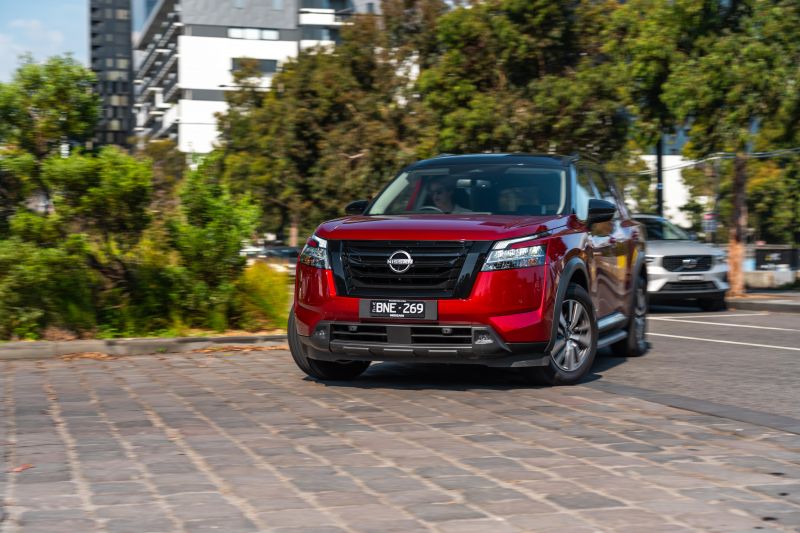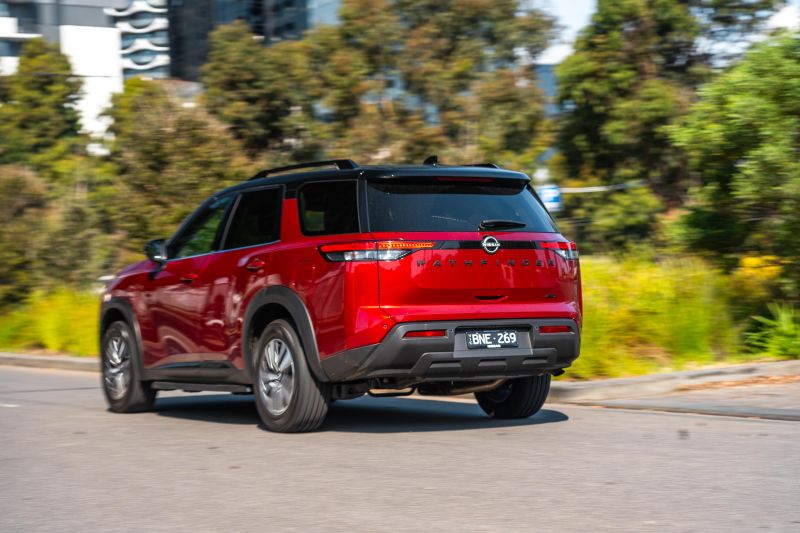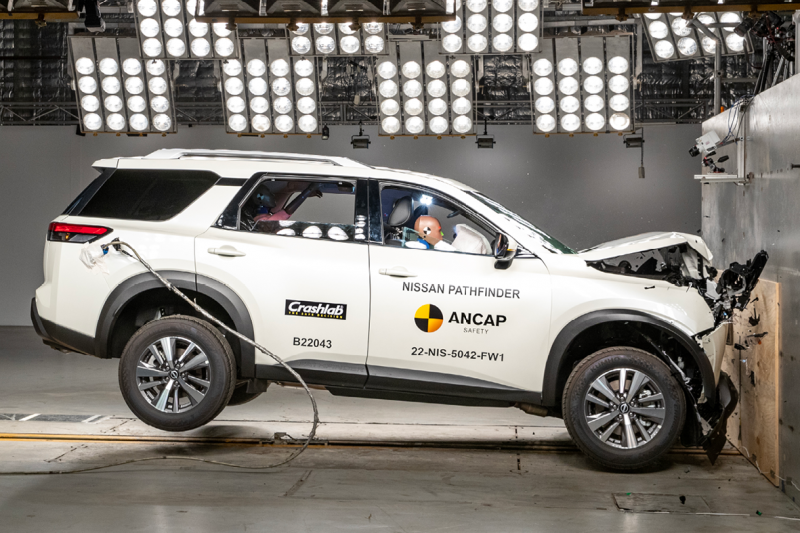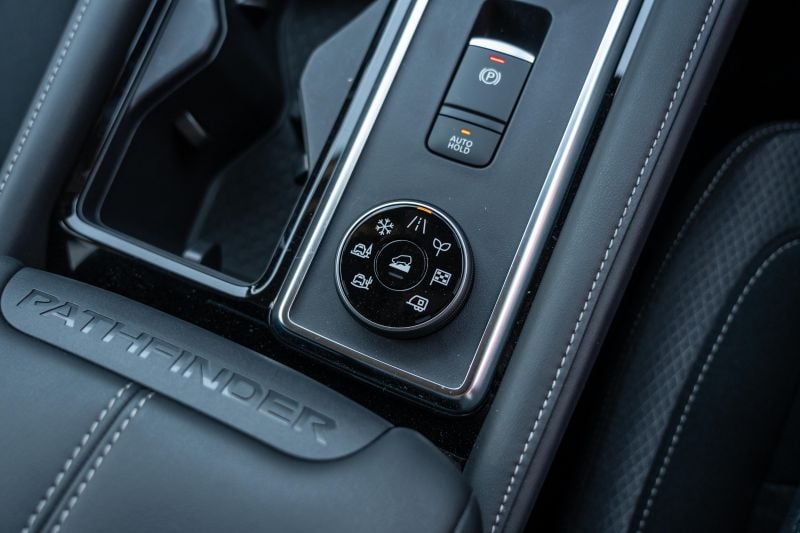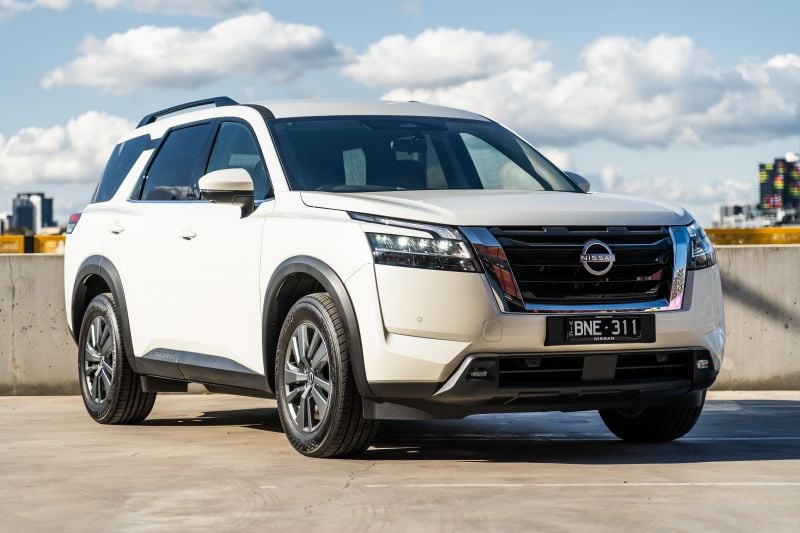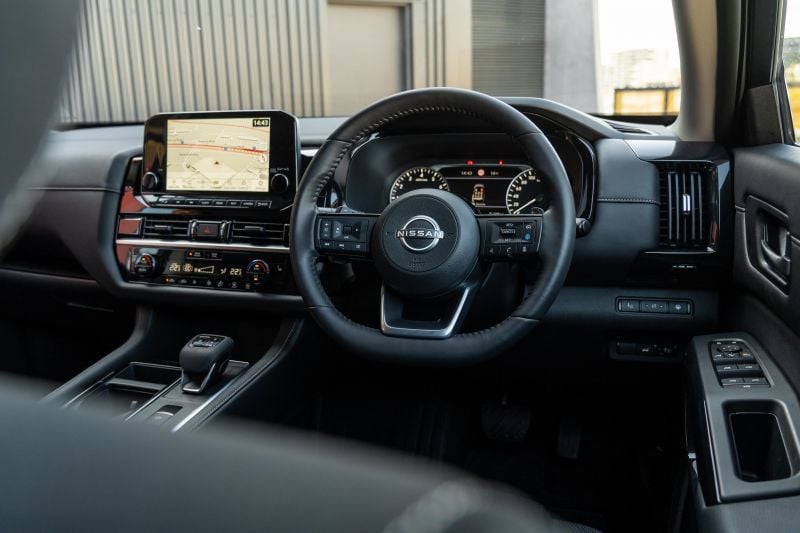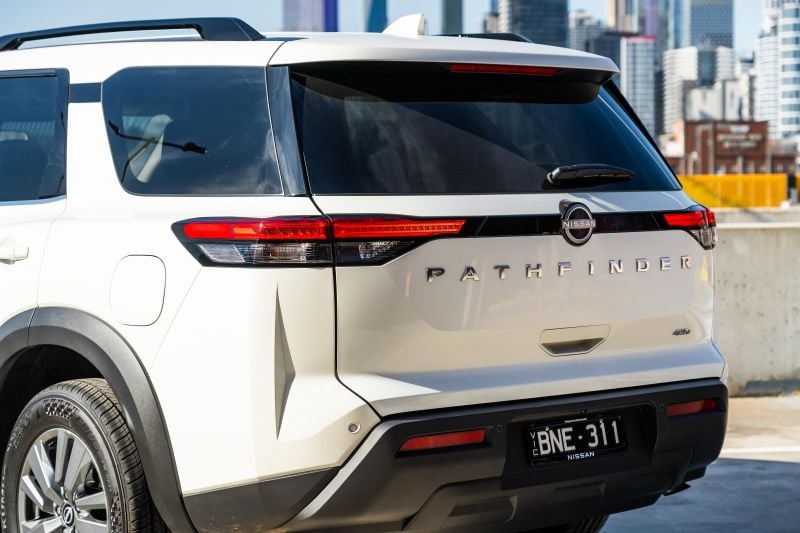Nissan Australia has finally reintroduced more affordable versions of its Pathfinder family SUV.
In February 2023 the front-wheel drive Nissan Pathfinder ST and Ti – as well as the all-wheel drive ST-L – were removed from price lists due to supply constraints.
High demand for the all-wheel drive Ti and Ti-L was also cited by the brand, but this left the range opening at $71,490 before on-roads rather than $54,190 plus on-roads when the front-drive ST opened the range.
Now, there is now some price relief, with the arrival of a new front-wheel drive ST-L, and the return of the aforementioned ST-L AWD and Ti FWD grades. On test here we have the Nissan Pathfinder ST-L AWD.
Priced from $64,170 before on-road costs, the ST-L AWD brings down the price of entry to the all-paw Pathfinder family, but is $2300 dearer than it was when it was last sold here.
WATCH: Paul’s video review of the 2023 Nissan Pathfinder Ti
The Pathfinder range has also expanded with just a single naturally aspirated V6 petrol option, a product of its North American target market, despite an increasing number of rivals offering electrified or even diesel-powered options.
With competition in this space as hot as ever, is Nissan’s eight-seat family hauler worth a look in today’s market?
How does the Nissan Pathfinder compare?
View a detailed breakdown of the Nissan Pathfinder against similarly sized vehicles.

Nissan
Pathfinder
How much does the Nissan Pathfinder cost?
While the new ST-L FWD opens the range under $60,000; the ST-L AWD on test has seen a $2380 price increase since it was last offered in Australia.
| Model | Price before on-road costs |
|---|---|
| Nissan Pathfinder ST-L FWD | $59,670 |
| Nissan Pathfinder ST-L AWD | $64,170 (+$2380) |
| Nissan Pathfinder Ti FWD | $67,990 (+$2080) |
| Nissan Pathfinder Ti AWD | $72,490 (+$1000) |
| Nissan Pathfinder Ti-L AWD | $82,490 (+$1000) |
To see how the Nissan Pathfinder lines up against the competition, check out our comparison tool.
What is the Nissan Pathfinder like on the inside?
The Pathfinder is very modern Nissan inside, which has its strengths and drawbacks.
It’s a huge departure from the previous Pathfinder, which had interior elements that dated back to the late noughties and early 2010s. This new car is far more modern, but is already looking dated in some areas.
The freestanding 9.0-inch touchscreen infotainment system is well featured; with native satellite navigation, DAB+ digital radio and wireless Apple CarPlay all standard. Android Auto, however, is wired only.
It runs the current Nissan-Mitsubishi interface, which is simple and easy to use, though at times can be a touch laggy and some of the graphics are looking a bit old. I’m still not sure why the Pathfinder misses out on the availability of the nicer 12.3-inch touchscreen available in the smaller X-Trail and Qashqai.
The analogue gauge cluster is another example. While clean and somewhat attractive, the setup feels dated compared to the flatter and more digitised displays offered by competitors. The Hyundai Santa Fe or Kia Sorento, by comparison, feel much more tech-laden and premium in this respect.
If you’re not tech-obsessed, though, everything works fine. The Pathfinder goes far to offer very comfortable, couch-like front chairs that offer power adjustment for the driver, plus leatherette-lined and top-stitched surfaces and details, as well as a lot of cabin storage.
The ST-L’s cloth trim is supple but feels hard wearing, and there’s a good level of adjustment in both the driver’s seat and the steering wheel to find a comfortable driving position.
Build quality feels pretty solid in this American-built Nissan, and there are subtle lashings of piano-black trim over the climate control pod – with physical controls, hurrah! There are big cupholders, plus cubbies throughout to stow phones, wallet, keys… you name it.
Clever standouts include the big storage cubby under the centre bridge courtesy of the shift-by-wire system, and the door bins are also more than capable of swallowing big bottles and the like.
Parents with two or three children will be well catered for by the second row, which has heaps of space for child seats or lanky teenagers. The middle seat is a little skinny, but it means the outer seats are almost as comfortable as the fronts.
The second row slides and reclines, and there’s a one-touch function that allows easier access into the rearmost row of seating. But, the smaller portion of that split-folding section is on the left-hand side, which is street-side in right-hand drive Australia.
If you’re transporting three across the rear bench, the flat floor helps free up foot- and toe-room so your backseat bandits aren’t constantly playing an aggressive game of footsies – I’m the eldest of three, so I know it can turn into WW3.
You get plenty of comfort features too, like a third zone of climate control with ceiling-mounted ventilation; USB-A and -C charging ports at the rear of the centre console; a fold-down centre armrest with cupholders; map pockets on the backs of both front seats; and bottle holders in the doors.
Unlike most three-row SUVs in Australia, the Pathfinder offers a three-seat third-row bench. So, you have up to eight seats to play with – making the Nissan a rival to the Hyundai Palisade as well as people movers like the Kia Carnival.
It’s not quite people mover spacious, though, as there’s a higher floor with the SUV AWD hardware underneath the rear-end, but with the second row slid a little forward there’s better leg and knee room than in many segment rivals. But it could be better, given how much space is still left behind the third row of seats.
There’s also a third ISOFIX anchor point on the left-side third-row seat to go with the two on the outboard second-row seats, but the high shoulder line and chunky side interior panels might make outward visibility challenging for smaller, nausea-prone children.
Boot space is rated at 205 litres with the third row in use, 554 litres with the third row folded and 782 litres with both the second and third rows stowed.
It sounds limited on paper, and while Nissan doesn’t quote the measurement type it appears it’s measured to the base of the window line, which is quite low. As you can see from the pictures, there’s quite a lot of space on offer if you measure to the head restraints or even the roofline.
Nissan fits a space-saver spare wheel under the boot of the Pathfinder, compared to the full-size spares employed by some rivals. Still, it’s better than a tyre repair kit.
| Dimensions | Nissan Pathfinder ST-L AWD |
|---|---|
| Length | 5004mm |
| Width | 1978mm – excl. mirrors |
| Height | 1798mm |
| Wheelbase | 2900mm |
| Cargo capacity | 205 litres – 3rd row up 554 litres – 3rd row folded 782 litres – 2nd, 3rd row folded |
To see how the Nissan Pathfinder lines up against the competition, check out our comparison tool.
What’s under the bonnet?
The Pathfinder is solely available with a 3.5-litre naturally aspirated V6 petrol engine.
| Specifications | Nissan Pathfinder ST-L AWD |
|---|---|
| Engine | 3.5L V6 petrol |
| Power | 202kW at 6400rpm |
| Torque | 340Nm at 4800rpm |
| Transmission | 9-speed auto |
| Driven wheels | All-wheel drive |
| Weight | 2052kg – kerb |
| Fuel economy (claimed) | 10.5L/100km |
| Fuel tank capacity | 71 litres |
| Fuel requirement | 91 RON |
| CO2 emissions | 245g/km |
| Emissions standard | Euro 5 |
| Braked towing capacity | 2700kg 270kg – towball download |
To see how the Nissan Pathfinder lines up against the competition, check out our comparison tool.
How does the Nissan Pathfinder drive?
It’s been a while since I’ve driven a Pathfinder, and this revisit in its most humble form was actually quite pleasant.
-
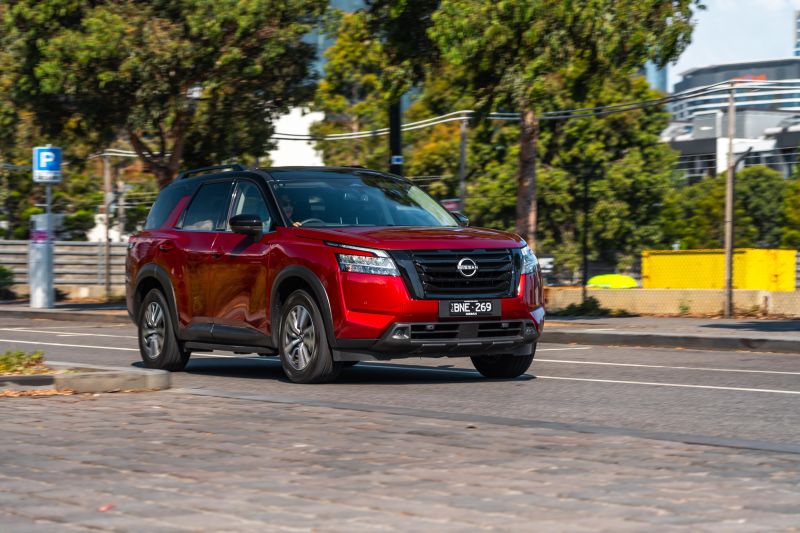
Pathfinder Ti shown
The 3.5-litre petrol V6 is a little old-school but it’s beautifully smooth and rev-happy, working well with the sharp-shifting nine-speed automatic transmission.
In typical naturally aspirated fashion, it’s nicely responsive to inputs and linear in how it delivers its power. On the flipside, it often has to rev out quite hard to get moving quickly and also needs to shuffle through gears since peak torque of 340Nm doesn’t come on tap until a lofty 4800rpm.
For those that enjoy non-turbocharged, large-capacity engine response, this will be nicely familiar. But for those used to the punchy low-down response of turbocharged petrol and diesel alternatives, you might be left wanting for more.
Thankfully, the V6 has a nice brassy tone as you rev it out – perhaps nicer than even the twin-turbo V6 in the Z coupe…
Fuel economy also suffers as a result. While Nissan claims a combined 10.5L/100km for AWD variants, we only got close to that with more highway use.
The lack of idle stop/start tech and the thirsty nature of big-bore petrol engines means in stop-start peak-hour traffic you’ll easily see the trip computer show 12-13L/100km.
At least it’s comfortable and pretty refined all round, with a comfort-leaning softer suspension tune that is pretty typical of American-focused cars. Insulation from road and wind noise is also decent for the class.
The Pathfinder happily cruises in town or on the highway with a stable feel, and irons out the lumps and bumps of Australian roads.
Being a big, soft family SUV, the Pathfinder hasn’t been designed to carve out apexes and tear up B-roads.
The Pathfinder’s light steering and soft suspension tunes make it easy to drive in daily scenarios despite its hefty size, but while the steering response is accurate it’s not super feelsome and might feel overly assisted to some.
Props to Nissan for including a surround-view camera as standard equipment including Moving Object Detection, though the actual quality and resolution of the cameras leaves a bit to be desired compared to rival nameplates.
You have good outward visibility thanks to the tall glasshouse, though the chunky A-pillars and side mirrors might take a bit to get used to if you’re coming out of a smaller car.
As for driver assistance, the Pathfinder follows Nissan’s other new models in being decked out with intuitive assists.
ProPilot combines adaptive cruise and lane centring functions for semi-autonomous highway driving, and it largely does a good job save for the odd occasion it drifts a little too close to the lines on either side.
Blind-spot and rear cross-traffic assist provide active intervention to prevent collisions, and the audible warnings aren’t ear-piercingly annoying.
All this makes it a vast – even a two-generation – jump over the old Pathfinder, and definitely keeps the Nissan competitive with rival vehicles from Hyundai and Toyota.
What do you get?
The ST-L is currently the entry point into the Pathfinder lineup in Australia.
Pathfinder ST-L standard equipment:
- 8 seats
- 18-inch alloy wheels
- Automatic LED headlights
- Automatic high-beam
- Roof rails
- LED fog lights
- Power tailgate
- 9.0-inch touchscreen
- 10.8-inch head-up display
- 7.0-inch TFT instrument cluster display
- Wireless Apple CarPlay
- Wired Android Auto
- DAB+ digital radio
- 6-speaker sound system
- Satellite navigation
- Black cloth upholstery
- 8-way power driver’s seat with lumbar control
- Heated front seats
- Tri-zone climate control
- Power-folding and heated exterior mirrors
- Keyless entry and start
- ‘EZ Flex’ latch-and-glide seating adjustment
- Leather-accented steering wheel
- Tilt and telescopic steering wheel adjustment
- Electric parking brake
- 2 x USB-A outlets
- 2 x USB-C outlets
- 2 x 12V outlets
- Remote start
- Rear privacy glass
Colours
Standard: $NCO
Premium: $750
- Scarlet Ember
- Super Black
- Gun Metallic
- Brilliant Silver
- Ivory Pearl
- Deep Ocean Blue Pearl
Two-tone: $1400 (Ti, Ti-L)
- Boulder Grey with Black roof
- Scarlet Ember with Black roof
- Ivory Pearl with Black roof
- Gun Metallic with Black roof
Is the Nissan Pathfinder safe?
The Nissan Pathfinder received a five-star ANCAP safety rating based on testing conducted in 2022.
| Category | Nissan Pathfinder |
|---|---|
| Adult occupant protection | 86 per cent |
| Child occupant protection | 93 per cent |
| Vulnerable road user protection | 78 per cent |
| Safety assist | 85 per cent |
Standard safety equipment on all models includes:
- 9 airbags
- Adaptive cruise control with speed limiter
- Autonomous emergency braking
- Pedestrian detection
- Cyclist detection
- Junction assist
- Forward + Reverse
- Blind-spot assist
- Lane departure warning
- Lane keep assist
- ProPilot
- Adaptive cruise control + lane centring
- Rear cross-traffic alert
- Rear seat alert system
- Surround-view cameras
- Traffic sign recognition with over-speed prevention
- Tyre pressure monitoring
How much does the Nissan Pathfinder cost to run?
Like the wider Nissan lineup, the Pathfinder is covered by a five-year, unlimited-kilometre new vehicle warranty including five years of standard roadside assistance.
| Running costs | Nissan Pathfinder |
|---|---|
| Warranty | 5 years, unlimited kilometres |
| Roadside assistance | 5 years |
| Service intervals | 12 months or 15,000 kilometres |
| Capped-price servicing | Up to 5 years |
| Total capped-price service cost | $2215 – 2WD $2333 – AWD |
To see how the Nissan Pathfinder lines up against the competition, check out our comparison tool.
CarExpert’s Take on the Nissan Pathfinder
The most affordable Pathfinder AWD puts in a solid, if somewhat uninspiring showing.
It’s a big, comfortable and practical SUV that will happily haul your family and keep them safe on the road, and even at this more attainable trim level offers plenty of features and tech to keep it current for some time.
Those that appreciate tougher looks will likely enjoy its bulky and boxy proportions, which also translate to quite a spacious cabin for those carrying at least five people regularly.
The Pathfinder offers solid on-road performance with a sweet, rev-happy engine, comfy and refined driving characteristics and decent manoeuvrability for something measuring 5.0m long and nearly 2.0m wide.
But, this segment is as hot and competitive as ever, and the Pathfinder falls behind numerous rivals in several key areas.
First up, drivetrain. While a sweet revver and smooth operator, the 3.5-litre V6 is behind the times when it comes to low-down performance and outright fuel efficiency.
Idle stop/start would cut fuel use, but a proper hybrid option would bring down running costs, particularly for families conscious of weekly fuel bills and environmental aspects.
Next is the tech. Yes, the infotainment system is fine, as are the suite of driver assists, but the displays are tired in the face of new Chinese and Korean rivals, and that extends to the surround cameras which look like 480p feeds.
The ST-L trim on test also isn’t particularly ‘cheap’ given it’s currently the entry grade in Australia. Personally, the AWD version is only really necessary if you plan on frequenting the snow fields or navigate dirt roads regularly – otherwise, save the $4500 and get the FWD that’s much better value for money relative to the class.
Interested in buying a Nissan Pathfinder? Get in touch with one of CarExpert’s trusted dealers here
Click the images for the full gallery
MORE: Everything Nissan Pathfinder

